The Best Men’s Ski Jackets of 2024
This article originally appeared on Outside
More comfortable, better for the environment, and longer lasting. Those are the takeaway trends from the top resort ski jackets for this year. But after sorting through nearly 40 jackets, it's the diversity that really stands out. Whether you want all the warmth you can get, layering under a minimalist shell, or the best deal on the slopes, you will find it among our top picks from four months of testing during one record-breaking ski season.
The Winners at a Glance
Most Comfortable: Dakine Sender Stretch 3L
Best For All Conditions: Helly Hansen Alpha 4.0
Most Stylish: Strafe Hayden Jacket
Best Value: Columbia Highland Summit Jacket
Best For Sigle-Digit Temps: Mountain Hardwear First Tracks Down Jacket
Best Resort-Meets-Backcountry Jacket: Rossignol Evader
Most Eco-Friendly Insulated Jacket: Marmot Lightray
Best Breathable Shell: Trew Cosmic Jacket
Most Versatile: Salomon QST Jacket
Best Weather Protection: Arc'teryx Sabre Jacket
The Reviews: The Best Men's Ski Jackets of 2024
Most Comfortable: Dakine Sender Stretch 3L Jacket ($495)
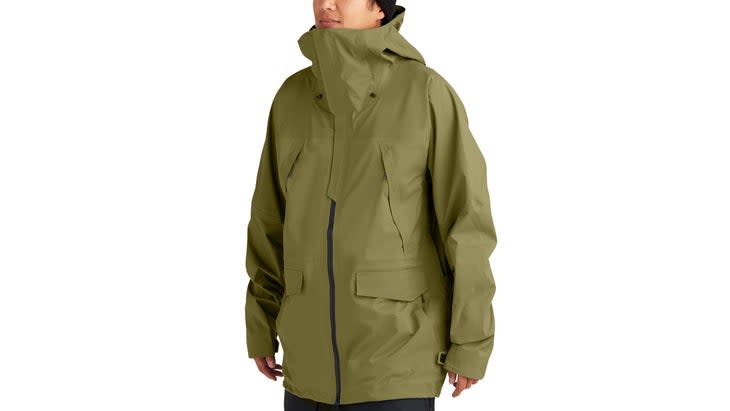
Weight: 1.6 lb
Size: S-XXL
Pros
Well organized pocket placement
Stretchy, soft material
Cons
Baggier fit than some skiers will like
The Stretch won admirers for the sum of its parts. The first thing everyone noticed was its namesake. The recycled and recyclable polyester that comprises the jacket has a buttery feel and a couple inches of give in every direction that makes good on its name. Tester Adam Jaber said the stretch made the fit seem custom. On its own the jacket is a little baggy. It pulled on easily over multiple layers on a chilly day at Vermont's Stratton Mountain and never restricted touring during spring laps at N.H.'s Tuckerman Ravine. Plus, the long cut with an even longer tail kept flakes from wandering where they shouldn't. When Jaber crashed hard, no slush slid into his pants. That sealed the deal for a jacket he was already loving. The five exterior and two interior pockets were right where he wanted them, the hood easily fit a helmet and cinched down snug, the pit zips dumped excess heat, the shell-style jacket was watertight in wet conditions. He even liked the color options. "This is my favorite sub-$500 shell," said Jaber. "Dakine knocked it out of the park. Buy this jacket and get the matching pants."
Bottom line: If you like it baggy, this was the best shell jacket we tested.
Best For All Conditions: Helly Hansen Alpha 4.0 Jacket ($475)
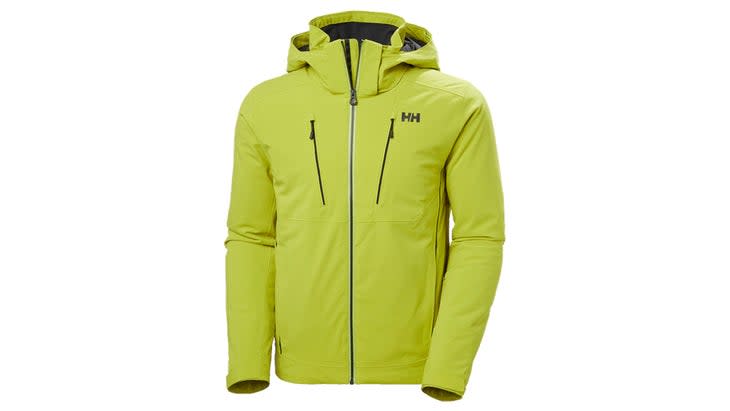
Weight: 2.4 lb
Sizes: S-XXL
Pros
Insulated phone pocket
Warmth without stuffiness
Cons
Narrow cuff gaiters don't play nice with cuffed gloves
Think of the Alpha as the best kind of environmentally-friendly choice--one without compromise. The four-layer design starts with an outer shell of Ocean Bound fabric, a polyester derived from salvaged fishing nets and marine plastic, backed by Helly's proprietary waterproof-breathable membrane. Then there's PrimaLoft Black Eco Ocean Bound, a recycled synthetic insulation. And finally a silky interior lining. The sandwich of layers is definitely warm, said ski instructor Chris Grover, who wore it with just a baselayer down to 15 degrees F. But even closer to freezing he rarely overheated because the insulation has holes in it that do a good job of locking in the warmth when it's cold and releasing the excess heat as the interior temperature rises. These are just a few of the jacket's many nice touches: an insulated phone pocket, fleece-lined hand pockets, adjustable powder skirt, Recco reflector, detachable hood, wrist gaiters. Fit was ideal for Grover's broader shoulders and chest, but the sleeves might come up short on lankier testers. But his favorite feature is the independent collar and hood design. He could deploy the hood even with the collar zipped up snug around the chin.
Bottom line: The breathable insulation makes the Alpha an ideal resort jacket for zones with big variations in winter temperatures.
Most Stylish: Strafe Hayden Jacket ($519)
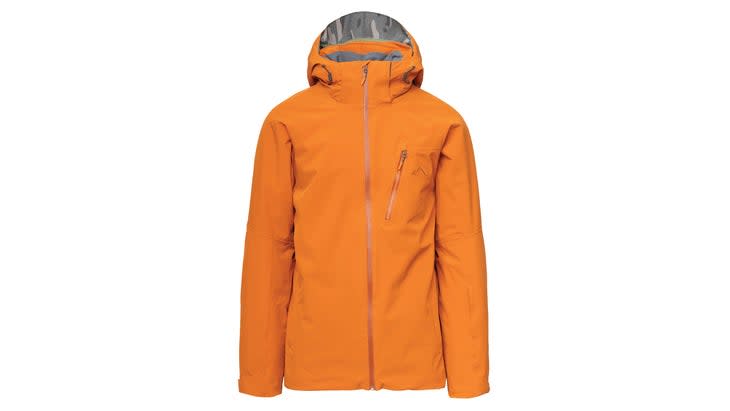
Weight: 2.4 lb
Sizes: S-XXL
Pros
Great fit and comfort
Best wrist gaiters we've used
Cons
On the bulky side
Slipping into this jacket is like getting a warm hug. The quilted interior lining is soft and smooth and glides on over midlayers. The stretchy wrist gaiters slip on unnoticed and still lock out cold and flakes. "They don't have a thumb loop so they fit great and don't interfere with gloves or poles," said Ryan Stuart. The hand pockets are fleece-lined. Both the recycled and waterproof polyester outer shell and PrimaLoft Silver P.U.R.E. recycled insulation (60 grams in the sleeves and hood and 100 grams in the body) have four-way stretch. Testers never felt constricted, even throwing tricks in the park. All together, the Hayden has the substantial feel of a weighted blanket--and the same comfort. Another chilly tester was warm enough down to 10 degrees F with two baselayers underneath. And it's customizable: The hood zips off and there are hidden vents for dumping heat. "You won't want to take it off," Stuart said.
Bottom line: The perfect ski travel jacket for mid-winter trips, ready for whatever weather and casual enough to wear out at apres.
Sponsor Content
Decathlon MT100 Hooded Down Jacket ($99.99)
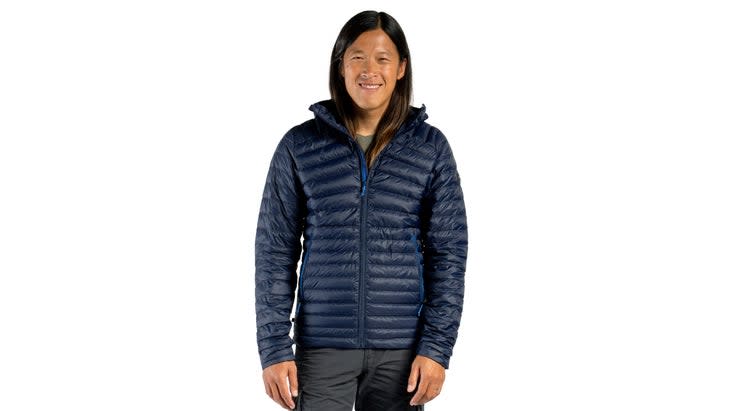
Meet the puffer that’s turning heads at the resort this winter. Insulated enough to keep you warm on the chilliest winter days, the MT100 Hooded Down Jacket is a total overachiever. While this puffer can keep you comfortable in temperatures between 23degF and 41degF with its ethically-sourced down and 800-fill-power, it’s also super lightweight and packable--so packable it can stuff into its left pocket. And if that weren’t enough, Decathlon also made the MT100 Hooded Down Jacket water-repellent to keep you dry all day long. It’s available in men’s and women’s sizes and in a range of colors.
Best Value: Columbia Highland Summit Jacket ($200)
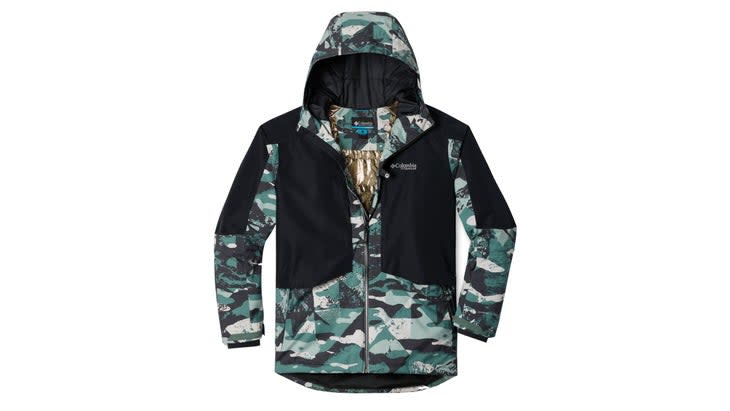
Weight: 1.1 lb
Sizes: S-XXL; 1X-6X; LT-5XT
Pros
Great price for warmth
All the features we like
Cons
Boxy fit on some
Our testers were loving this jacket even before they saw the great price. It's loaded with all the handy features we expect--pass pocket, inside zipper pocket, wrist gaiter, hand and chest pockets, powder skirt, and a helmet-friendly hood--plus a few nice extras, like a goggle lens pocket and a drop tail. Tester James Sjogren especially appreciated the latter while sitting on a soggy chairlift at Whistler. Instead of a soaker, he slid off warm and dry. The proprietary Omni-Tech waterproof-breathable membrane helped and did a great job of deflecting coastal (read: moist) flakes. Even more clutch to the jacket's impressive warmth for bulk ratio was the Omni-Heat Infinity, a metallic inner lining that reflects body heat back to the body. "It was like a thermostat," Sjogren says. "Throughout the winter, I wore the same layering and was always comfortable." Come spring, it got a little warm, but a less athletic skier could probably extend the season. Sjogren liked the look of the jacket, but older skiers weren't all fans. And on some testers the cut looked boxy. But if it fits, this is a fully loaded jacket at a bargain price.
Bottom line: A great value ski jacket for anyone who has trouble staying warm.
Best For Single-Digit Temps: Mountain Hardwear First Tracks Down Jacket ($350)
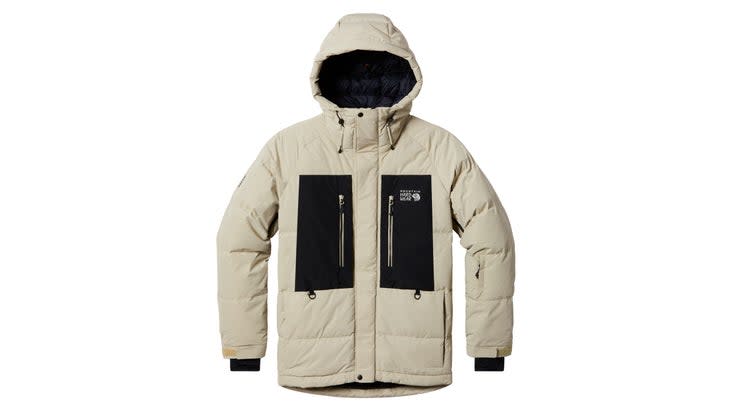
Weight: 2.5 lb
Sizes: S-XXL
Pros
Plenty of warmth for frigid days
Good value for a down puffy
Cons
Limited temperature range
Front snaps tricky with mitts on
Unless you're perpetually chilly or live in Fairbanks, this probably won't be your everyday resort jacket. But when the polar vortex drops in, it will keep you smiling and skiing, said category manager Ryan Stuart. He used it in 9 degrees F record lows on Vancouver Island last winter. That may not sound that bad, but when it plunges into the single digits in the Pacific Northwest, it feels colder than minus-40 in Alberta, he insisted. "Usually the moist cold gets into my bones and I'm the first guy to head in to warm up, but with the First Tracks I was the one going for another lap." The staying power comes from responsibly sourced, 650-fill down wrapped in a two-layer, windproof, recycled polyester outer. More protection came from an insulated hood that easily fit over the biggest helmet head, wrist gaskets that sealed glove leaks, and a draft collar that insulated the front zip. On the down side, the snaps on the draft collar were tricky to manage with thick gloves on. In warmer conditions, mesh-backed pit zips kicked up the A/C when needed, but, even wearing just a baselayer underneath, the First Tracks became a sauna above 25 degrees F. With good looks and a reasonable price, the First Tracks can do double duty as an around-town puffy and cold-weather ski jacket.
Bottom line: Ideal resort jacket for intermediate and advanced skiers who run cold or a dedicated cold-weather companion.
Best Resort-Meets-Backcountry Jacket: Rossignol Evader Jacket ($425)
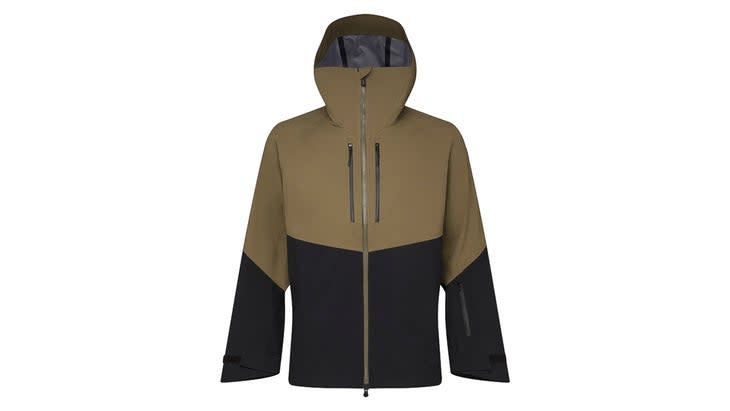
Weight: 1.8 lb
Sizes: S-XXL
Pros
Good looks
Stretchy fabric and fleece backing felt cozy
Cons
Wrist gasket interfered with social updates
Watch the sizing: medium fit like a large
"Nice jacket." Tester Chris Baikie heard it over and over wearing the handsome Evader. The praise wasn't just external. Baikie says the waterproof-breathable fabric combo had plenty of stretch and the design was roomy. It made it easy to add layers and move freely without feeling constricted. A thin, fleece lining from the neck up added a touch of warmth and next-to-skin comfort. Together, the jacket felt bomber, supple, and cozy all at the same time. The high, fleece-lined collar sealed his admiration. Zipped up snug in a blizzard, "I didn't need my Buff," he said. In above-freezing temperatures the pit zips helped dump excess heat, and being a shell he used it right through the spring corn cycle. His biggest nitpick: the thumb loops on the wrist gaiters interfered with texting. "First-world problems, I know," Baikie said. More noteworthy is the sizing, Baikie usually wears a large but a medium Evader fit perfectly. The shell style was packable enough to take backcountry skiing and ideal for people who run hot. Overall, Baikie says this jacket is less "nice" and more "niiiice!"
Bottom line: One jacket to go from the backcountry to the frontcountry in style.
Most Eco-Friendly Insulated Shell: Marmot Lightray Gore-Tex Jacket ($375)
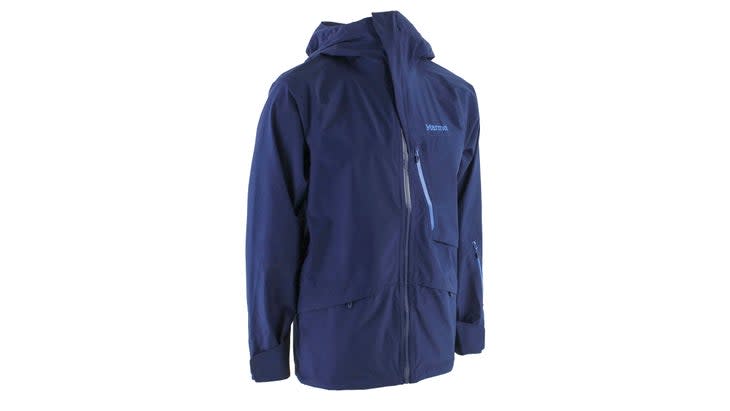
Weight: 1.6 lb
Sizes: S-XXL
Pros
Environmentally friendly
Lightweight for insulated jacket
Cons
Stocky testers found that it fit snug
Environmentally friendly stats may be the headline for Gore Tex's new ePE membrane, but its performance is what stood out to testers wearing the Lightray. Gore developed ePE to cut carbon emissions compared to its existing membrane formulation and to eliminate PFCs, toxic "forever" chemicals. The new membrane is also thinner and lighter, without impacting weather resistance or breathability. In the Lightray, that produced one of the lightest-feeling insulated ski jackets our testers tried. "It's a warm set up without being too sluggish or bulky," said Patrick Lowkes, a Vermont-based weekend warrior. Marmot paired the ePE with a recycled polyester, lightweight exterior fabric, PrimaLoft Black insulation and a soft liner. Skiing at Okemo Mountain, it kept Lowkes toasty down to 15 degrees and dry on a rainy day. Big and easy-to-operate armpit venting prevented overheating as the thermometer climbed. Another standout feature was the price. Testers thought this was one of the best deals we ran through the paces this year.
Bottom line: The best bet for value and environmentally conscious shoppers looking for an insulated shell that won't weigh them down.
Best Breathable Shell: Trew Cosmic Jacket Primo ($499)
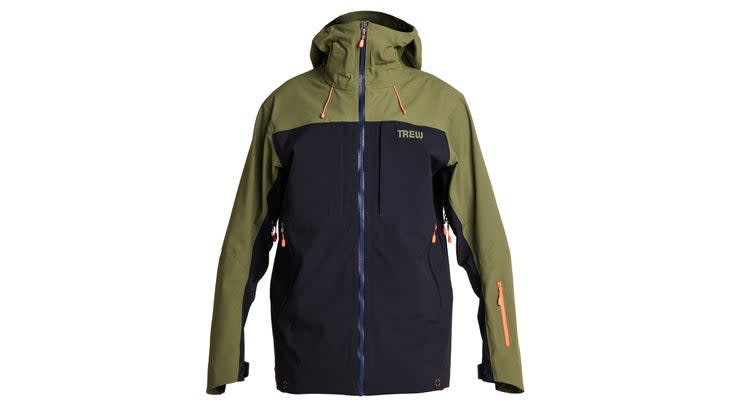
Weight: 1.6 lb
Sizes: XS-XXL
Pros
Hood deploys without undoing zipper
Super breathable
Cons
Needs an interior zipper pocket
The Cosmic is a classic style from Trew, but the company's new-last-season Primo fabric takes it to the next level. The jacket retains the same design: loose fit, double hand and double chest pockets, pass pocket on the sleeve, long pit zips, and one of the best hoods in the business. "I didn't even have to undo the neck zip to get the hood up over my helmet," said Chris Grover, a ski instructor at Vancouver Island's Mount Washington. The only thing missing is an inside zipper pocket. The minor detail became even more insignificant thanks to the Primo fabric and a few laps of hiking to inbound chutes in a 33 degree snowstorm. "I got pretty warm and it was snowing heavily," Grover said. "But I didn't get wet!" Trew worked with Toyota Textiles to develop Primo, its woven nylon waterproof-breathable fabric. It's abrasion resistant, has a hint of stretch and proved to be both exceptionally waterproof and highly breathable. It's also recycled and Bluesign approved. A nice variation on this year's earth tone theme, the Cosmic comes in the cheery colors we've come to love from Trew.
Bottom line: An excellent shell option for those who run hot and work hard.
Most Versatile: Salomon S/Lab QST GTX Pro Jacket ($700)
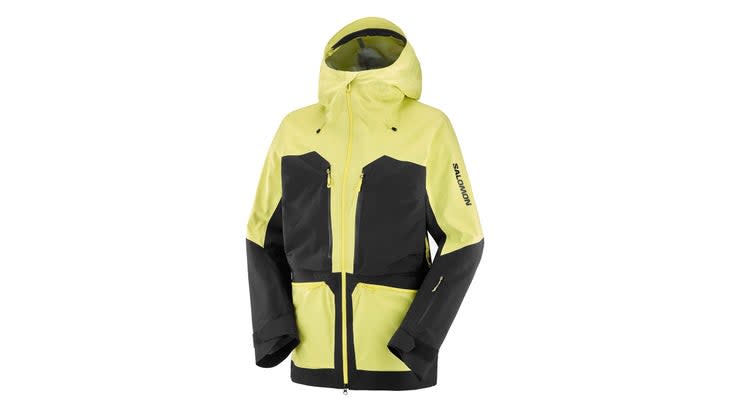
Weight: 1.6 lb
Size: S-XXL
Pros
Bomber weatherproofness
Excellent fit for a variety of body shapes
Cons
The bold bumblebee look is not for everyone
This jacket is winning in both directions in the tug of war between packability on one side and features and weatherproofing on the other. At 25 ounces this is no minimalist shell, but it's also not heavy for the category. "It was my only shell for a weeklong backcountry hut trip and I never regretted the choice, even when I wasn't wearing it," said category manager Ryan Stuart. On the other side of the line, it has every feature we look for in a resort jacket. There are pockets galore: five on the exterior, including two vertical hand pockets that work exceptionally well for holding an open beer. The hood is easy to cinch snug--even with mitts on--and "moved with my head," said Stuart. The GoreTex Pro membrane is bomber, keeping testers warm and dry in everything from howling wind to pouring rain. And the articulated and slightly longer cut fit multiple testers just right, whether they were skinning, boot packing with skis over a shoulder, sitting on a lift, or crushing bumps. The yellow and black combo wasn't anyone's favorite, but once the jacket was on, no one complained.
Bottom line: One shell for backcountry, slackcountry, and resort skiing.
Best Weather Protection: Arc'teryx Sabre Jacket ($750)
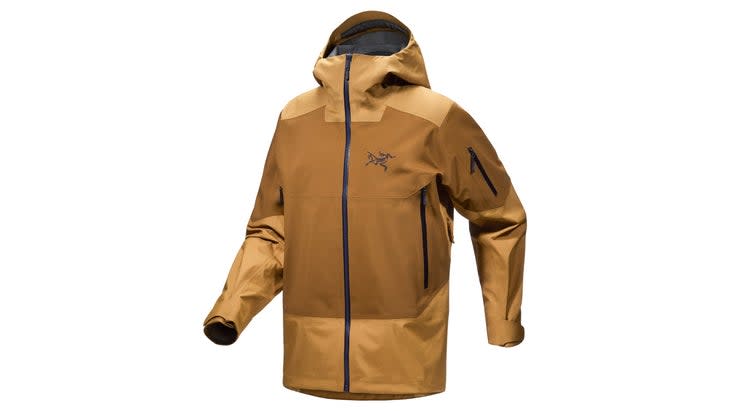
Weight: 1.6 lb
Size: XS-XXL
Pros
Durable construction
Warmth and comfort of flannel lining
Cons
Longer sleeves and narrow waist didn't fit all testers well
Pricey
Vancouver-based Arc'teryx has staked its reputation on making gear worthy of playing in the foul weather of its Coast Range backyard. So it made sense to us to hand it off to some folks who do so for a living. Ski bums, pro patrollers and ski instructors in the Sea to Sky region took the Sabre for laps in weather that ranged from rain-on-snow to bluebird pow. It returned from 15 days of abuse by four different testers in near pristine shape. "What a wicked jacket," was a typical comment. Another tester found the features (pass pocket, interior pocket, two hand pockets, powder skirt, and a helmet-compatible hood) were just the right amount and worked ideally, even with gloves on. "The pocket placement was perfect," he said. Some testers complained that the fit was a little long and narrow. But everyone was onboard with the material choice: a Gore Tex waterproof-breathable membrane sandwiched between a soft shell-like outer and a thin flannel liner. The latter added a nice feel to the jacket and a hint of insulation that backed up the solid weather protection. "It rained and blew all day," said one tester. "I was never cold and my base layer was dry when I got back to the car. Amazing."
Bottom line: An excellent Arc'teryx jacket for shell lovers who wouldn't mind a little more protection and warmth.
How to Buy
There are literally hundreds of ski jackets to choose from, which could make shopping overwhelming. To help whittle down your choices, ask yourself five simple questions.
Insulated or not? This is a matter of preference. Do you like to wear an uninsulated shell and dress in layers or wear a warmer jacket with just a base layer or two? If you're not sure, here's our advice. For milder parts of ski country and if you ski hot, we recommend a shell style jacket, so you don't overheat and can adjust to the conditions. Pick insulated if you regularly ski in temperatures below 20 degrees, if you're always chilly, or you live in the south and travel to ski.
Do you need waterproof fabric? We generally recommend buying a jacket with a waterproof membrane - we've gotten wet just about everywhere we've skied. The exception is for insulated jackets. Chances are you are only wearing these when it is cold out and getting wet isn't an issue. For insulated jackets a windproof membrane is sufficient. The best measure of a membrane's waterproofness is a water column measure. Look for 20,000 mm and above.
Do you like the way it looks? To love a jacket you have to like the way it looks. That means color and pattern and also the fit and cut - in other words how baggy it is. This can be tough to tell online, though pictures with a model help.
Does it have the features you want? Our minimum is a pass pocket, helmet compatible hood and hand pockets. Powder skirt, interior zip pocket and vents are nice additions. Everything after that is gravy. Figure out what you need and find the jacket with those features. For instance, if you like to carry an extra goggle lens make sure there's a pocket big enough.
Does it fit properly? More than just the style, this is about whether the jacket allows for a wide range of movement. Look for features like articulated sleeves and stretchy fabrics to improve mobility and adjustable cuffs, hem and hood to customize the fit. Trying on a jacket, it should have room for all the layers you usually wear, plus one.
Can you afford it? We think you get what you pay for and generally a higher priced jacket is going to work better and last longer. But there are many great value jackets, as well. They might not be quite as refined or use as high-quality materials, but they get the job done without breaking the bank.
How We Test
Number of testers: 16
Number of products tested: 39
Number of ski days logged: more than 500
Number of resorts skied during testing: 43-plus
We've seen just about every kind of ski jacket in use on the hill, everything from floater suits to sequined denim. So the first step in testing ski resort jackets is defining what makes a jacket suitable for skiing at the resort. To us, this category prioritizes jackets that put features ahead of weight and packability. They tend to have pass pockets, powder skirts, and helmet-compatible hoods, but otherwise it's a diverse lot that includes down puffies, thin shells, and everything in between. Once we decide if a jacket qualifies as "resort," we call in samples to test and distribute them around a team of testers that live in just about every corner of the continent. Mostly we let testers just go skiing. We think this is the best way to figure out what works and what doesn't. As they log days with the apparel, we ask them to think a little deeper about key variables like fit, function, breathability, warmth, and weather resistance. We also ask them to hand the jackets off to other skiers to get different perspectives. Each tester fills out a feedback form, and from that we whittle our list of jackets down to the nine standouts that you will find reviewed here.
Meet Our Lead Testers
At some point last winter, category manager Ryan Stuart celebrated his 40th year on skis. He learned to ski at six years old on the T-bar at Calgary's Paskapoo Ski Hill, now Canada Olympic Park. The other 39 winters have taken him around the world, from Japan to Italy, Alaska to Vermont. Last year he tested ski jackets in Utah, British Columbia, Quebec, and on Vancouver Island, where he lives. When he's not trying out ski resort apparel, he's running the ski test for Ski Canada Magazine and working on a book about the history of skiing in Canada. @ryanpstuart on Twitter
Tester Adam Jaber is the creator of Out of Collective, a network of outdoor related podcasts that includes his own Out of Bounds Podcast. He's also the marketing manager for Colorado Skis & Bikes and a motivated skier. He logged 71 days last year at 19 different resorts in four countries. @adam_jab on Instagram
Chris Baikie figures his dual ski roles are ideal for jacket testing. Every Friday he volunteers with an adaptive ski program. Teaching anyone to ski means "standing around a lot," he says. "Your gear has to be waterproof and weatherproof or you will freeze." The role also involves plenty of bending over, a good test of mobility. Then on weekends Baikie tries to up his run count, while trying to ditch his ripping kids. He's working hard and skiing fast, putting jackets through the other extreme.
More From the 2024 Winter Gear Guide
The Best All-Mountain Skis
The Best Backcountry Skis
The Best Alpine Ski Boots
For exclusive access to all of our fitness, gear, adventure, and travel stories, plus discounts on trips, events, and gear, sign up for Outside+ today.

